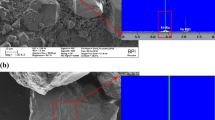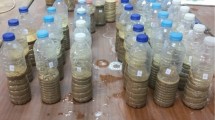Abstract
Nanoscale zero-valent iron (NZVI) particles can be used for in situ groundwater remediation. The spatial particle distribution plays a very important role in successful and efficient remediation, especially in heterogeneous systems. Initial sand permeability (k 0) influences on spatial particle distributions were investigated and quantified in homogeneous and heterogeneous systems within the presented study. Four homogeneously filled column experiments and a heterogeneously filled tank experiment, using different median sand grain diameters (d 50), were performed to determine if NZVI particles were transported into finer sand where contaminants could be trapped. More NZVI particle retention, less particle transport, and faster decrease in k were observed in the column studies using finer sands than in those using coarser sands, reflecting a function of k 0. In heterogeneous media, NZVI particles were initially transported and deposited in coarse sand areas. Increasing the retained NZVI mass (decreasing k in particle deposition areas) caused NZVI particles to also be transported into finer sand areas, forming an area with a relatively homogeneous particle distribution and converged k values despite the different grain sizes present. The deposited-particle surface area contribution to the increasing of the matrix surface area (θ) was one to two orders of magnitude higher for finer than coarser sand. The dependency of θ on d 50 presumably affects simulated k changes and NZVI distributions in numerical simulations of NZVI injections into heterogeneous aquifers. The results implied that NZVI can in principle also penetrate finer layers.






Similar content being viewed by others
References
Bradford SA, Bettahar M (2006) Concentration dependent transport of colloids in saturated porous media. J Contam Hydrol 82:99–117. doi:10.1016/j.jconhyd.2005.09.006
Bradford SA, Scott RY, Bettahar M, Simunek J (2002) Physical factors affecting the transport and fate of colloids in saturated porous media. Water Resour Res 38:1327. doi:10.1029/2002WR001340
Bradford SA, Simunek J, Bettahar M, van Genuchten MT, Yates SR (2006) Significance of straining in colloid deposition: evidence and implications. Water Resour Res 42(12): W12S15. doi: 10.1029/2005WR004791
Hazen A (1893) Some physical properties of sands and gravels with special reference to their use in filtration. 24th Annual Report, Massachusetts State Bureau of Health. Publ Doc 34:553–556
He F, Zhang M, Qjan T, Zhao D (2009) Transport of carboxymethyl cellulose stabilized iron nanoparticles in porous media: column experiments and modelling. J Colloid Interface Sci 334:96–102. doi:10.1016/j.jcis.2009.02.058
Hosseini SM, Tosco T (2013) Transport and retention of high concentrated nano-Fe/Cu particles through highly flow-rated packed sand column. Water Res 47:326–338. doi:10.1016/j.watres.2012.10.002
Köber R, Hollert H, Hornbruch G, Jekel M, Kamptner A, Klaas N, Mangold K-M, Martac E, Matheis A, Paar H, Schell H, Schiwy A, Schmidt K, Strutz TJ, Thümmler S, Tiehm A, Braun J (2014) Nanoscale zero-valent iron flakes for groundwater treatment—a new type of nano iron. Environ Earth Sci 72(9):3339–3352. doi:10.1007/s12665-014-3239-0
Kozeny J (1927) Über kapillare Leitung des Wassers im Boden. Sitzungsber Akad Wiss Wien 136:271–306
Laumann S, Micic V, Hofmann T (2014) Mobility enhancement of nanoscale zero-valent iron in carbonate porous media through co-injection of polyelectrolytes. Water Res 50:70–79. doi:10.1016/j.watres.2013.11.040
Li Y, Wang Y, Pennell KD, Abriola LM (2008) Investigation of the transport and deposition of fullerene (C60) nanoparticles in quartz sands under varying flow conditions. Environ Sci Technol 42:7174–7180. doi:10.1021/es801305y
Pankow JF, Cherry JA (1996) Dense chlorinated solvents and other DNAPLs in groundwater. Portland, Oregon
Phenrat T, Cihan A, Kim H-J, Mital M, Illangasekare T, Lowry GV (2010a) Transport and deposition of polymer-modified Fe0 nanoparticles in 2-D heterogeneous porous media. Effects of particle concentration, Fe0 content, and coatings. Environ Sci Technol 44:9086–9093. doi:10.1021/es102398e
Phenrat T, Kim H-J, Fagerlund F, Illangasekare T, Lowry GV (2010b) Empirical correlations to estimate agglomerate size and deposition during injection of a polyelectrolyte-modified Fe0 nanoparticle at high particle concentration in saturated sand. J Contam Hydrol 118:152–164. doi:10.1016/j.jconhyd.2010.09.002
Raychoudhury T, Tufenkji N, Ghoshal S (2014) Straining of polyelectrolyte-stabilized nanoscale zero valent iron particles during transport through granular porous media. Water Res 50:80–89. doi:10.1016/j.watres.2013.11.038
Reardon EJ (2005) Zerovalent irons: styles of corrosion and inorganic control on hydrogen pressure buildup. Environ Sci Technol 39(18):7311–7317. doi:10.1021/es050507f
Reardon EJ, Fagan R, Vogan JL, Przepiora A (2008) Anaerobic corrosion reaction kinetics of nanosized iron. Environ Sci Technol 42:2420–2425. doi:10.1021/es0712120
Schlicker O, Ebert M, Fruth M, Weidner M, Wüst W, Dahmke A (2000) Degradation of TCE with iron: the role of competing chromate and nitrate reduction. Groundwater 38:403–409. doi:10.1111/j.1745-6584.2000.tb00226.x
Strutz TJ, Hornbruch G, Dahmke A, Köber R (2016) Effect of injection velocity and particle concentration on transport of nanoscale zero-valent iron and hydraulic conductivity in saturated porous media. J Contam Hydrol. doi:10.1016/j.conhyd.2016.04.008
Su C, Puls RW, Krug TA, Watling MT, O’Hara SK, Quinn JW, Ruiz NE (2013) Travel distance and transformation of injected emulsified zerovalent iron nanoparticles in the subsurface during two and half years. Water Res 47:4095–4106. doi:10.1016/j.watres.2012.12.042
Tosco T, Sethi R (2010) Transport of non-Newtonian suspensions of highly concentrated micro- and nanoscale iron particles in porous media: a modeling approach. Environ Sci Technol 44:9062–9068. doi:10.1021/es100868n
Tratnyek PG, Johnson RL (2006) Nanotechnologies for environmental cleanup. Nanotoday 1:44–48. doi:10.1016/S1748-0132(06)70048-2
Wei Y-T, Wu S-C, Chou C-M, Che C-H, Tsai S-M, Lien HL (2010) Influence of nanoscale zero-valent iron on geochemical properties of groundwater and vinyl chloride degradation: a field case study. Water Res 44:131–140. doi:10.1016/j.watres.2009.09.012
Zhang C, Werth CJ, Webb AG (2007) Characterization of NAPL source zone architecture and dissolution kinetics in heterogeneous porous media using magnetic resonance imaging. Environ Sci Technol 41:3672–3678. doi:10.1021/es061675q
Acknowledgments
This research was integrated in the joint project “NAPASAN” (Nanoparticles for ground water remediation) and was funded by the Federal Ministry of Education and Research (BMBF, Grant Number 03X0097D, NanoNature, Wing).
Author information
Authors and Affiliations
Corresponding author
Additional information
Responsible editor: Philippe Garrigues
Electronic supplementary material
Below is the link to the electronic supplementary material.
ESM 1
(DOCX 1.33 mb)
Rights and permissions
About this article
Cite this article
Strutz, T.J., Hornbruch, G., Dahmke, A. et al. Influence of permeability on nanoscale zero-valent iron particle transport in saturated homogeneous and heterogeneous porous media. Environ Sci Pollut Res 23, 17200–17209 (2016). https://doi.org/10.1007/s11356-016-6814-y
Received:
Accepted:
Published:
Issue Date:
DOI: https://doi.org/10.1007/s11356-016-6814-y




